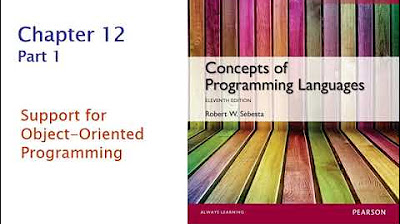445 2 types abstraits signaturev6
Summary
TLDRThe script discusses the concept of abstract type signatures in programming. It covers how types, such as integers, lists, or custom types, are defined and how operations related to these types are declared with formal arguments and result types. The example illustrates inserting an element into a list and explains how different characters, such as underscores, can be used to position arguments. The script also highlights the hierarchy of defined and predefined types, as well as the distinction between internal operations, which modify data, and observers, which retrieve information.
Takeaways
- 🔢 Abstract types consist of a type zone to define sets of values such as integers, stacks, queues, and graphs, and an operation zone to define properties of the types.
- 📝 Operations in abstract types are defined by a name and a profile, which outlines the formal declaration of arguments and the type of their results.
- 🛠️ Example: The 'insert' operation inserts an element at a specified position in a list. It takes three arguments—list, index (integer), and element—and returns a modified list.
- 💻 Operations can be used in algorithms like functions, with the identifier followed by arguments enclosed in parentheses.
- ✍️ The operation name can indicate the place of arguments using underscores, which are replaced by actual values during execution.
- ⚙️ Parentheses can be used to clarify the order of operations and remove ambiguity, particularly in complex expressions.
- 🔢 Constants in programming can be declared without arguments, such as the integer zero or the symbol for pi.
- 🔗 Abstract types can reuse previously defined types (like integers or booleans) without needing to redefine them.
- 📊 In defining a vector type, integer types can represent positions, and the data type can represent any kind of element (e.g., numbers, clothes, car parts).
- 📚 Internal operations modify the data, while observer operations only return values without modifying the type.
Q & A
What is the primary purpose of the 'Type zone' in abstract type signatures?
-The 'Type zone' in abstract type signatures is used to specify sets of values, such as integers, stacks, queues, graphs, or any custom type that needs to be defined. It helps in identifying the nature of the data used within the program.
What role does the 'Operation zone' play in an abstract type signature?
-The 'Operation zone' defines the properties of the types being described. Each operation is identified by a name and its profile, which includes the formal declaration of its arguments and the type of result it returns.
How are operations like 'insert' used in algorithms?
-Operations are used like functions, where their identifier is followed by parentheses containing the actual arguments corresponding to the formal parameters. For example, 'insert' would take a list, an integer (the index), and an element as arguments, returning a modified list.
What restrictions exist when naming operations in abstract type signatures?
-Almost all characters and glyphs can be used in operation identifiers, except for spaces (used to separate data), parentheses (used for prioritizing operations), and underscores (used for positioning operation arguments).
How can underscores be used in operation names to simplify expressions?
-Underscores can be used in operation names to indicate the positions of arguments, making the expressions more concise. For instance, instead of using parentheses, the arguments replace the underscores in the order they appear.
What distinguishes an internal operation from an observer operation in an abstract type?
-An internal operation returns a result of a newly defined type and typically modifies the data itself, while an observer operation returns a result of a predefined type and simply observes or retrieves information without modifying the data.
What is the difference between predefined types and newly defined types in this context?
-Predefined types are types that already exist, such as integers or booleans, while newly defined types are those created by the user, such as a 'vector' type in the script. Predefined types are specified in the 'use' section, while new types are defined in the 'Type' section.
How does the concept of a vector type illustrate the use of predefined types?
-The vector type uses predefined types like integers (for indexing) and elements (which can be any data type, such as numbers or objects). By reusing these predefined types, the vector type can manage a collection of data without redefining basic concepts like numbers.
What are some examples of internal operations and observer operations in the vector type signature?
-In the vector type, 'modify' is an internal operation because it modifies the vector itself by changing an element at a specific position. 'im', 'borne1', and 'borneSup' are observer operations because they retrieve values without modifying the vector: 'im' returns an element, while 'borne1' and 'borneSup' return the lower and upper bounds of the vector.
What does it mean for an operation to be a constant, and how is this represented in the script?
-An operation is considered a constant if it has no arguments in its profile. Examples of constants include 'zero' for an integer, 'true' or 'false' for a boolean, and 'pi' for a real number. These constants represent fixed values that do not require any input to be defined.
Outlines

Esta sección está disponible solo para usuarios con suscripción. Por favor, mejora tu plan para acceder a esta parte.
Mejorar ahoraMindmap

Esta sección está disponible solo para usuarios con suscripción. Por favor, mejora tu plan para acceder a esta parte.
Mejorar ahoraKeywords

Esta sección está disponible solo para usuarios con suscripción. Por favor, mejora tu plan para acceder a esta parte.
Mejorar ahoraHighlights

Esta sección está disponible solo para usuarios con suscripción. Por favor, mejora tu plan para acceder a esta parte.
Mejorar ahoraTranscripts

Esta sección está disponible solo para usuarios con suscripción. Por favor, mejora tu plan para acceder a esta parte.
Mejorar ahora5.0 / 5 (0 votes)






